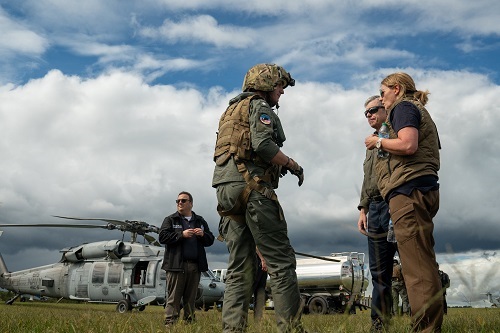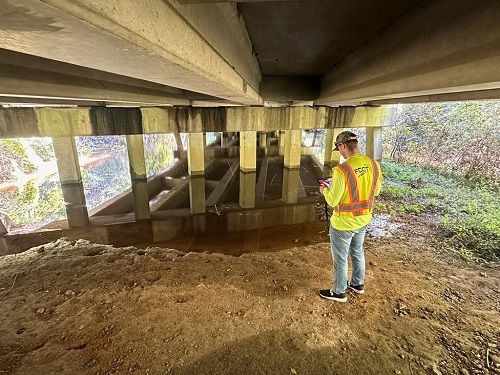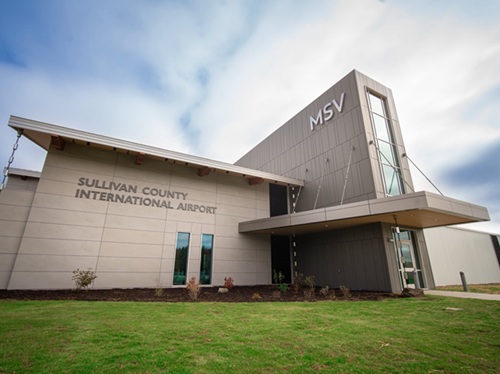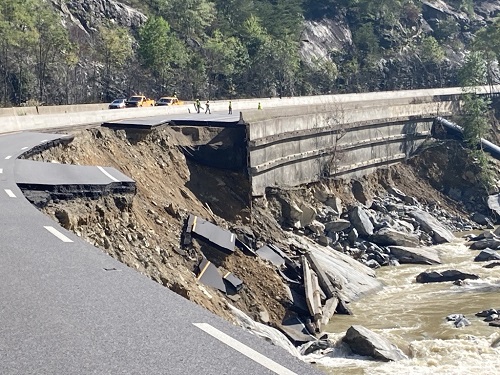Across the southeast, state departments of transportation are aiding in cleanup, recovery and infrastructure repair efforts in the wake of Hurricane Helene. The storm is estimated to have dumped between 20 trillion and 40 trillion gallons of water on the region, caused some $35 billion or more in damages, and took hundreds of lives.
[Above photo by the NCDOT]
North Carolina was the hardest hit by Helene’s rainfall and winds, with the western part of the state inundated with severe flooding that wiped out entire communities and cut others off from surface transportation routes.

President Joe Biden and Governor Roy Cooper (D) toured areas affected by the storm by air, with the president approving a 100 percent Federal Emergency Management Agency reimbursement for six months, a significant funding commitment from the federal government, as well as giving the green light for active-duty military personnel and equipment to support recovery operations in Western North Carolina.
“The damage caused by Hurricane Helene to Western North Carolina is immense, and we are continuing our unprecedented efforts to surge resources into affected communities,” the governor noted in a statement.
The North Carolina Department of Transportation warned on October 2 that travel remains dangerous in Western North Carolina, with approximately 450 roads closed. In terms of storm response, the agency has deployed 1,600 employees plus 68 contract crews; 1,500-plus trucks, graders, and backhoes/loaders; 1,000-plus chainsaws; and 8,000-plus barricades and signs.
In the first state hit by Helene – which made landfall on September 26 – the Florida Department of Transportation deployed over 2,100 FDOT personnel to work directly on storm response: Manning heavy equipment; clearing debris; inspecting roads and bridges for damage; and staffing emergency operations centers.
As of October 2, according to the Florida Governor’s office, Florida DOT “Cut and Toss” operations on state-owned facilities are complete, except for inaccessible areas or roadways with hazards. Over 800 crew members cleared more than 12,300 miles of roadway, including 61 crews who cleared I-10 in under six hours after the storm made landfall.

The agency also deployed 129 bridge inspectors who inspected, reviewed, and cleared some 1,400 accessible state-owned and locally-owned structures by October 2. Florida DOT personnel also inspected 9,000 traffic signals in the affected region, restoring power to those locations that lost electricity.
All three causeways in the Greater Tampa Bay area were repaired and cleared within 24 hours of Helene’s landfall, with Florida DOT crews removing over 50,000 cubic yards of sand. The agency is also assisting rail industry partners and utility companies in removing downed power lines and fiber-optic cables across rail lines in areas struck by Helene, to ensure efficient mobility of goods and supplies throughout Florida’s rail network.
The Florida DOT also participated in “Operation Blue Ridge,” a multi-state agency effort launched by Gov. DeSantis on September 29 in the immediate aftermath of Helene to provide recovery assistance to North Carolina and Tennessee, which suffered major flooding and infrastructure damage from the storm.
The South Carolina Department of Transportation pre-staged equipment and people in western areas of the state ahead of Helene, who then busily cleared roads across affected areas of storm debris.
Meanwhile, Tennessee Governor Bill Lee (R) said eight counties in the eastern part of his state received expedited Major Disaster Declarations, while the Tennessee Department of Transportation has deployed over 400 personnel to assess damage, clear debris, and inspect all 310 state-owned bridges in Eastern Tennessee that span water, 310 bridges across six counties in East Tennessee.

In a statement, the agency said Hurricane Helene “has caused historic destruction” resulting in the anticipation of “hundreds of millions of dollars in damage and months of closures” to roads and bridges in the area.
Finally, the Georgia Department of Transportation noted in a statement that after “less than a week” of recovery efforts by its personnel and contractors in Southwest Georgia, state routes are “passable” with “just a handful of intersections” in need of repair and areas where debris removal needs to continue.
“We’re in pretty good shape,” said Scott Chambers, Georgia DOT’s Southwest District engineer.
 Top Stories
Top Stories
New Study Finds Cannabis Use Impacting Vehicle Crashes
October 17, 2025 Top Stories
Top Stories

